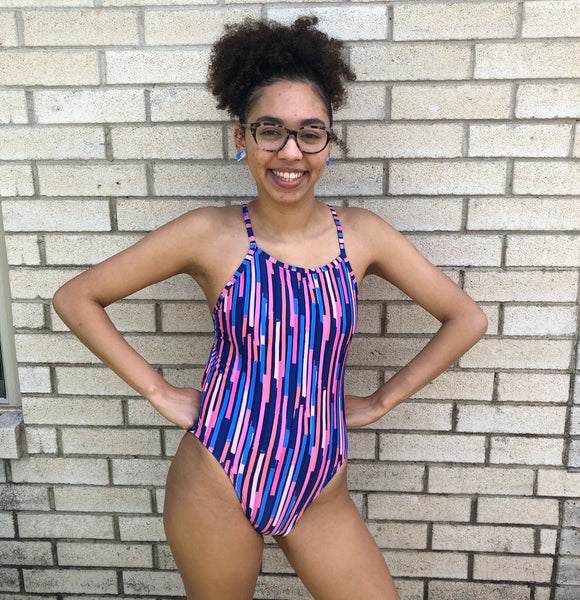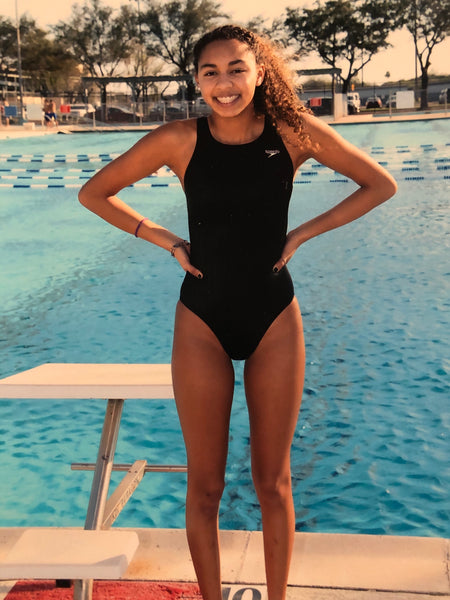Meet Bri Miller: Aquatic Athlete and Lifeguard

"We not only must be aware of the racial inequality that exists in the daily aspects of our lives and actions but work towards making all spaces more inclusive and welcoming. This includes our pools."
As one of the many steps to educate ourselves and begin helping to make the pool more diverse, we set up an email that customers can reach out to with their ideas for diversity or just a story they’d like to share (equality@jolyn.com). We received many emails, and one of them especially caught our eye. Meet Briana Miller, a swimmer, water polo player, lifeguard, and overall inspiring woman. Bri was gracious enough to share not only her journey throughout her aquatics career but also navigating that journey as a woman of color. Without further adieu, meet Briana Miller in our July edition of Women Who Inspire Us.
Tell us a little bit about yourself! Where are you from? What aquatic sports do you play? How long have you been playing them?
My name is Briana Miller. I am from the Rio Grande Valley, a region in deep south Texas along the U.S.-Mexico border. I am a recent graduate of Wellesley College (Go golden class of 2019!) and I am planning to start my master’s program in American Studies at Brown University in the Fall. I’ve essentially been swimming my entire life. I started at 7-months at my local Red Cross Learn-to-Swim Parent/Baby program. I started swimming competitively at age 11 mostly because my two older siblings also swam competitively. When I entered college, I decided to switch sports and played water polo for my college’s club team.

Why did you switch from swimming competitively to playing water polo competitively?
After graduating high school, I felt like I had really burned out of swimming competitively. I realized that I really didn’t enjoy the pressure I placed on myself when swimming by myself in a lane, but I also realized that what I really loved was the team dynamic of relays. So when I entered college, I decided to join the Wellesley Club Water Polo Team. The support and dynamic that comes with playing a team sport was something that I felt I really needed and really cherished during my four years playing water polo. If playing water polo was an option in my hometown or at my high school, I would have definitely started at a younger age.
What advice do you have for other women wanting to make that same transition?
Just go for it! Whether a transition from swimming to water polo or an aquatic sport to a land sport, your interests are worth trying. It’s not guaranteed that it will be easy, trust me. But the learning curves and the challenges are what make the transition process so much more exciting.
What has been your biggest accomplishment in your aquatics career thus far?
Throughout my time swimming and playing water polo, I feel that I have accomplished quite a bit. Some of these accomplishments are small like completing my first 50 fly at a competition or making skip shots for the first time at a random water polo practice. If I had to choose my biggest accomplishment in aquatics thus far, it would be helping Wellesley win its first game at the national level at the Collegiate Water Polo Association Club National Championships against Grinnell College in 2018. Getting to share this moment with my team was an absolutely priceless experience.
How did you get into lifeguarding?
I started lifeguarding at 16 as a summer job. Both of my older siblings were lifeguards and I already spent so much of my time growing up at my local pool, so becoming a guard felt quite natural.
What is the most common thing you see as a lifeguard?
This might sound cliché, but the most common thing I saw as a lifeguard was kids running on the deck. If only I received a dollar for every time I told a kid not to run.
As a black woman, do you feel like your aquatic sports experience has been affected by race in any way?
100%. For most of my aquatic sports career, I was the only Black person on my team. There were many times where I would go to competitions and still be the only Black competitor. When I was younger, I used to dismiss this observation, telling myself, “Oh well it’s because I live in a region that is 90-95% Latinx.” Then when I began to compete at the state level through the Texas Amateur Athletic Federation (TAAF), I would tell myself, “Oh, it’s just Texas.” But as a child, when I looked towards the U.S. Olympic swim team, it mirrored my situation. Not much was different even at the highest levels of the sport. During my college years, my team and I would travel throughout New England for tournaments, but, once again, not much was different. I was still one of the few if not the only one. To have limited role models that look like you in a sport that you really love can be really disheartening. I can’t say I ever felt like an imposter because my love for swimming has always been my source of self-validation, but that doesn’t mean I don’t recognize the reality of my situation.

What are some ways in which athletes and coaches alike can impact and affect change in their sport to encourage diversity and inclusion for BIPOC athletes?
Step one is to always educate yourself. Ask yourself, “Why are there so few BIPOC swimmers? Why does the stereotype that Black people don’t swim exist? Are aquatic sports accessible to a variety of different people?” While internationally we are having conversations surrounding racism as they relate to anti-Blackness and police brutality, we must use this moment to truly evaluate how the system of racism impacts and influences our everyday lives and the lives of those around us. If we want to fully address the systemic nature of racism in the U.S., then we not only must be aware of the racial inequality that exists in the daily aspects of our lives and actions but work towards making all spaces more inclusive and welcoming. This includes our pools.
Another important way to impact and affect change is to show support for programs that advocate for swimming in minority communities. Black children ages 5-19 are 5X more likely to drown than their white peers, and this is linked to a lack of swim education and water safety due to inaccessibility. Programs like the Make A Splash Foundation and Swim 1922 are doing really important work on this front.
You are also a swim instructor! What do you think is the first thing someone should learn before they get in the water?
Unfortunately, I wasn’t able to return to lifeguarding this summer as I had planned due to COVID-19, but part of my responsibility as a lifeguard was to serve as a swimming lessons instructor through the Red Cross’ Learn-to-Swim program. As a former swim instructor, I think it is very important to make the distinction between swim education and water safety. While water safety is definitely an important part of swim education, water safety also includes tips and tools on how to assess your own skills when entering pools, lakes, beaches, or even tubs. One of the first things to be taught in levels 1 & 2 of the Learn-to-Swim Program, where many of the students are ages 4-9, is for the child to be aware of the pool/body of water they are entering and knowing where they are safe with or without a guardian present. While this might seem like a given, an individual’s knowledge of how to safely assess their situation in the water is something that is learned and developed. So if water safety information and education are not accessible to everyone, then, unfortunately, their safety is at risk.